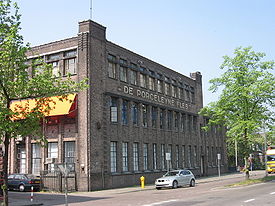- De Koninklijke Porceleyne Fles
-
The Koninklijke Porceleyne Fles (aka, Royal Delft)[1] is the only remaining factory of the 32 earthenware factories that were established in Delft during the 17th century. It is known for its Delftware production, which has been active for more than 350 years, without interruption[2].
History
Delft Blue started in The Netherlands around the 17th century when the VOC (the Dutch East India Company) brought the blue painted porcelain back from China. This resulted in an inspiration for the Dutch ceramists, because this fragile porcelain was not created or seen before.
For Royal Delft, it all started in 1653 when David Anthonisz van der Pieth transformed his house into an earthenware factory. Unfortunately for Van der Pieth his son was far from interested in this business and therefore he had to sell his factory real soon. This was not extremely difficult because 42 years later this industry was booming in Delft! Royal Delft already had 32 competitors in that year. Of course this was made possible by the high demand for the product and because of the decrease in beer breweries that were suited for transforming into earthenware factories. However, the most important reason, was probably that in the 17th century China faced a civil war which decreased the import of porcelain.
Though, this industry did not remain as booming as in the 17th century because in the 19th century (1840 to be precise) Royal Delft was the last factory standing. The reasons for this decrease are mostly to be found in the competition from the English Wedgwood and European porcelain industry; the eastern porcelain was cheaper and… a lack of innovation amongst the Delft potters.
In 1876 Joost Thooft bought the factory with the aim to revive the production of Delft Blue. He was very interested in Delft Blue and made the factory be as booming as in the 17th century again. Thooft also worked together with Leo Senf, one of the most important designers of the history of the factory.
In the 17th century, Royal Delft had several factories all over Delft. However, this was very inconvenient and in 1916 all the activities were centralised in the location which is still the current visiting address of the factory, at the Rotterdamseweg in Delft. Three years later, the company was awarded by the Royal Family the ‘Royal’ in its name, which is a sign of appreciation for the contribution of Royal Delft for the Dutch Delft Blue industry. Nowadays, the relation with the Dutch Royal Family is still close.
In 2003 the company celebrated its 350th anniversary which it did by launching a new line called Jubilee.
References
External links
Categories:- History of the Netherlands
- Manufacturing plants in the Netherlands
- Manufacturing company stubs
- Dutch company stubs
Wikimedia Foundation. 2010.

